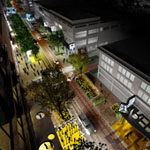Visit the new Fay and Gus Jones House website!
Naming of the School
In 2008, Don and Ellen Edmondson of Forrest City, Arkansas, made a substantial gift to the University of Arkansas School of Architecture, with the provision that the school be renamed in honor and in memory of Fay Jones, who had been an influential teacher to Don Edmonsdon during his college years, and who had designed the home of the Edmondsons in Forrest City some years before. The school subsequently became the Fay Jones School of Architecture + Design, a name still carried today, now also in memory of Don and Ellen, and their generosity to the school.
Stewardship of the House and the Steward
In 2015, the daughters of Fay and Gus Jones donated the house belonging to their late parents to the Fay Jones School of Architecture + Design and to the University of Arkansas. The house, itself a celebrated design completed by Fay Jones in 1956, has become a significant component of the curriculum in the Fay Jones School of Architecture + Design, and is emblematic of the aspirations and interests of the Fay Jones School in terms of its stewardship of the natural and built environments, as well as in respecting and celebrating the accomplishments of its most famous graduate. The house is maintained as a teaching resource, and its use and interpretation is led by Gregory Herman, Associate Professor of Architecture, Director of the Fay and Gus Jones House Stewardship, as a community outreach facility that may be toured, where the legacy of Fay Jones can be considered in situ, and the preservation of the works from the fullness of Jones’ career can be studied.
UA Possession, Maintenance and Usage of the Archives
The Fay Jones Collection, a component of the University of Arkansas Libraries’ Special Collections department, is a complete archive holding all papers, drawings, photos, correspondences, models, and other ephemera from the personal life, professional office, and teaching career of Fay Jones, FAIA, the American Institute of Architects’ Gold Medalist (their highest honor) for 1990. This extensive archive is accessed by many academics annually, and maintains its relationship to the Fay Jones School through collaborative projects, exhibits, and research by both faculty and students, and by outside scholarly parties. The archive also serves as the primary repository of information available to owners of building designs by Fay Jones, and it is available and accessible to owners, researchers, and other interested parties alike by appointment.
Distinguished Chair in Architecture
In 1999, Don and Ellen Edmondson, former clients of Jones, created an endowment to establish the E. Fay Jones Chair in Architecture, a position currently held by Marlon Blackwell, FAIA, Distinguished Professor of Architecture and 2020 AIA Gold Medalist. The Fay Jones Chair “…provides funding for a faculty member who is ‘nationally respected in the field of architecture, supplying the resources required to build upon and enhance the scholar’s contribution to teaching, research and public service.’ In addition, this chair position will promote the contribution of Jones through the discipline of architecture and to cultural attitudes toward design quality. Past holders of this position include David Buege, a Professor of Architecture in the Fay Jones School, and Lawrence Scarpa, of Brooks + Scarpa Architects in Los Angeles.”1
Faculty in History and Preservation
The Fay Jones School now offers a Master of Design Studies in Preservation Design for students of diverse educational backgrounds. Potential candidates are asked to contact the school for more information. Three full-time faculty are currently engaged in instruction in Preservation Design and History in the Fay Jones School:
- Ethel Goodstein-Murphree, BARCH, MA, PhD, Associate Dean and Professor
- Kimball Erdman, BA, MLARCH, PhD, Professor
- Gregory Herman, BARCH, MARCH, Associate Professor
Publications
The Fay Jones School has a robust publishing agenda, and is fully engaged in advancing new documentation and knowledge focused on Fay Jones and his work, as well as on allied topics that are of interest to scholars and to general enthusiasts. We are proud to announce that we are currently producing a newly revised edition of the canonical text on Fay Jones’ work, authored by Robert Ivy. Other titles produced by the Fay Jones School include:
- Shadow Patterns: Reflections on Fay Jones and His Architecture, Edited by Jeff Shannon, 2017
- Of the Soil: Photographs of Vernacular Architecture and Stories of Changing Times in Arkansas, by Geoff Winningham, 2014
- Louis I. Kahn: The Nordic Latitudes, Per Olaf Fjeld and Emily Randall Fjeld, 2019
- Just Below the Line: Disability, Housing, and Equity in the South, Korydon H. Smith, Jennifer Webb, and Brent T. Williams, Foreword by Edward Steinfeld, 2010
- Interpreting Kigali, Rwanda: Architectural Inquiries and Prospects for a Developing African City, Korydon H. Smith and Tomà Berlanda, 2018
- Barns and Portrait Paintings, George Dombek, Commentary by Henry Adams, Laura M. Terry, and Louis A. Zona, 2014
- Architects of Little Rock: 1833-1950, Charles Witsell and Gordon G. Wittenberg, 2014
Exhibitions and Conferences
The Fay Jones School has wholly or in part originated or sponsored several exhibitions and conferences focused on the breadth of Jones’ work, beginning in 2009, with a Fay Jones Symposium, with panel contributions from Robert McCarter, noted scholar of one of Jones’ mentors, Frank Lloyd Wright; Roy Reed, former New York Times columnist who conducted three-year oral history with Jones; and Robert Ivy, editor-in-chief of Architectural Record. Glenn Murcutt, 2002 Pritzker Prize laureate and 2009 AIA Gold Medal Honoree, also gave a lecture. Since that time, the school has maintained a permanently located and regularly changing lobby display of graphic material related to Jones, has sponsored an NEH-funded project for the creation of a digital experience of the work of Jones, and has encouraged essays and exhibitions focused on Jones’ work at scholarly conferences nationwide. Additionally, the school recognizes Jones’ birthday, January 31, each year with a school-wide celebration, that has become a much-anticipated event in the school calendar. The Fay Jones School is always looking for opportunities to bring the work of its namesake to existing audiences, but is most enthusiastic about bringing awareness of this brilliant work to new audiences as well.
Fay Jones Dean's Medal
Dean Peter MacKeith initiated the Fay Jones Dean’s Medal in 2015, the year after he was appointed dean of the school, and it was first awarded in 2016. MacKeith created the Dean's Medal honor to recognize the recipient's significant contributions to the architecture and design culture of Arkansas and to the Fay Jones School's students and their education. Over the previous five years, the Fay Jones School has given out 18 additional Dean's Medals recognizing individuals and organizations.
"The Dean's Medal is intended to recognize individuals and organizations who would not otherwise be affiliated with the school as alumni or as faculty or as staff, but who we believe, with us, serve the greater good of the state and serve the common cause of the betterment of the built environment," MacKeith said.2
Past Dean's Medal recipients include Urban Land Institute Northwest Arkansas, Evo Business Environment, Arkansas Museum of Fine Art, Northwest Arkansas Land Trust, Go Forward Pine Bluff, Murphy Arts District (El Dorado), The Lawrence Group (Wilson) and StudioMain (Little Rock/North Little Rock), Sunny Evans, Gay Anthony, TheatreSquared, U.S. Forest Service, John Ed and Isabel Anthony, Steve Lair, Lisa Lutz, Carolyn Allen, Kevin Wilcox, Walton Family Foundation, Robert Ivy, Arkansas Natural and Cultural Resources Council (ANCRC), Timothy Hursley and June Freeman.
Students
With the primary mission of providing an architectural education to Fay Jones School students, the school is always interested in engaging students in all initiatives regarding Fay Jones. The Fay and Gus Jones House is a primary vehicle for that effort, providing students with the opportunity to assist with interpretation of the house as a prime example of Jones’ work, and as a superior example of Mid-Century American Modernism, with strong roots in the vernacular / regional tradition of the upland Ozarks. Students have developed materials documenting the Jones house (and other houses designed by Jones) for the Historic American Buildings Survey (Peterson Prize laureates several times); they have also produced analytical materials regarding the house, and continue to use the house regularly as a meeting place, a place for sketching, and as a place for design inspiration.



